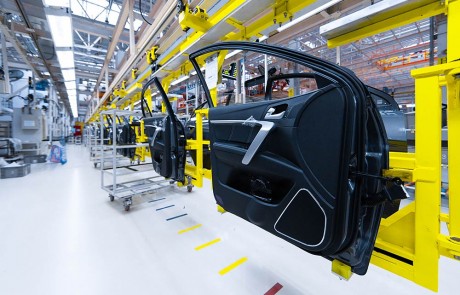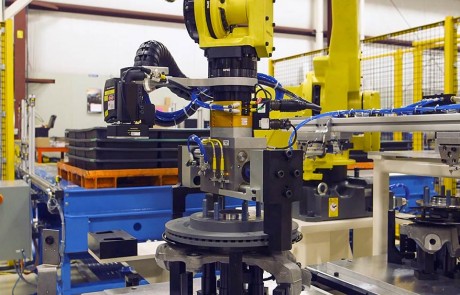Edgewater Automation in Automotive and Transportation Industries
As an early adopter of machine vision, robotics, material handling, and all forms of automation technologies, the automotive and transportation industry has been a primary driver of technology adoption by the manufacturing sector. Today, around the world, the automotive industry is a major driver for the adoption of manufacturing automation systems, automated testing and assembly, and the productivity and quality gains that come with successful automation technology projects. In short, the automotive industry has been a precursor and champion of today’s Industry 4.0, characterized by machine-to-machine communication.
With so much emphasis on highly automated mass production, quality requirements that can affect human safety, and a high degree of cost sensitivity, manufacturers of automobiles, commercial vehicles, and aerospace and related vehicles place a premium on having a close and trust-based collaborative relationship with suppliers and technology providers that support a high degree of automation and robotic solutions in production processes.
Automotive and Transportation Assembly Processes Ready for Automation Technology
As experts in robotic systems integration, machine vision, discrete motion control, and test systems, with offices in Michigan and South Carolina, Edgewater Automation has extensive expertise working with automotive and transportation OEMs and Tier 1 and Tier 2 supplier companies. Our past automation technology projects include manufacturing, assembly verification, packaging, inspection, and automated product tracking for many major automotive, commercial vehicle, and aerospace assemblies.
Recent projects have involved the automated assembly, inspection, and packaging of engine components and of fuel, braking, and HVAC systems, as well as chassis and suspensions, safety restraints, pumps, controls, tiers, electronics, palletizing/depalletizing systems, and much more.
Automated processes for the automotive and transportation industry often include small part assembly, leak testing, functional testing, machine vision inspection, and hard tool gauging. Edgewater has experience with all types of automated systems and work cells, from complete assembly lines to individual robotic work cells, robot machine tending, multi-robot cells, and more.
Our familiarity with SCARA, delta, gantry, six-axis, and other robotic models helps us guide our customers to the most cost-effective robotic solutions for their automation applications. For example, adding a seventh axis by positioning a robot on a rail-based moving platform can allow a single automation investment to solve multiple machine tending and other needs.
Inspection, Machine Vision, and Quality Assurance
After product assembly, quality assurance is critical for the automotive industry. Whether using 2D or 3D machine vision as part of white-body inspection; TIG, MIG, or laser welding and weld inspection; or providing force feedback controls for robotic cutting, deburring, and routing, Edgewater has the visual inspection systems and the expertise you need to solve your complex transportation assembly and quality assurance applications.
Edgewater has extensive experience with all forms of industrial testing, including best fit testing, repeatability and reliability (R&R) testing, area scanning 2D machine vision, line scan machine vision for large-area inspection, and end-of-line testing. Whether the automotive assembly application requires hi-pot electrical testing, gas testing, or LabVIEW integration with existing test equipment for better-quality reporting and data collection, let Edgewater guide your next quality assurance project.
Robotic System Produces Brake Assemblies
The North American automotive industry requires roughly 70 million brake assemblies annually. A multi-station robotic solution designed and built by Edgewater Automation in St. Joseph, Michigan, has streamlined production of those assemblies. Using multiple robots and 3D vision, the system increases throughput, improves worker safety, and reduces manual labor, saving the customer time and money.
Measuring 12 by 12 by 15 inches, the compact system uses vibratory bowl feeders for small parts. Robots handle large parts. Screwdriving and pressing operations assemble the parts, and vision systems verify that components have been correctly assembled.
The automated system had to overcome two production hurdles. First, bulk delivery containers were not precision molded, which affected automation. Edgewater used mechanical devices combined with vision-guided robots to overcome the variation.
Second, dust shields were delivered in stacks of 120 plates that leaned at a 25-degree angle. Edgewater programmed variable offsets in the robot tool angle and added compliance to the robot’s end-of-arm tool.
Edgewater’s conveyor-based automation system assembles 120 brake corner modules per hour for a major automotive customer. The system is currently tooled to produce two variants of the brake assembly.


